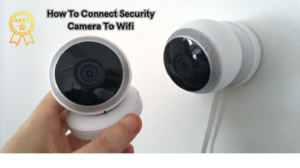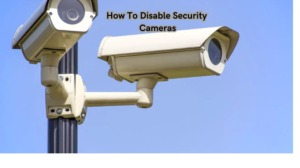Wireless camera jammers are devices that interfere with the signals between wireless cameras and their receivers, preventing them from recording or transmitting video. They can be useful for maintaining privacy in sensitive areas or protecting against potential surveillance.
Making your own wireless camera jammer may seem like a daunting task, but it can be done with just a few simple components and some basic knowledge of electronics. In this guide, we will walk you through the steps of building your own wireless camera jammer, so you can have peace of mind knowing that your privacy is protected.
Materials
To make a wireless camera jammer, you will need the following materials:
- Breadboard and jumper wires
- 9-volt battery or power supply
- Voltage regulator
- Capacitor and resistor
- Transistor
- Antenna
- RF oscillator module
- Soldering iron and solder wire
Step by Step Method For Building A Wireless Camera Jammer
There are a few different methods for building a wireless camera jammer, but we will focus on one of the simpler and more effective approaches. Follow these steps to create your own device:
Step 1: Gather Components
Before you dive into building your wireless camera jammer, make sure you have all the necessary components. These can easily be found online or at your local electronics store. Make sure to purchase a breadboard and jumper wires that are compatible with the other components you will be using.
Also, decide on the type of power source you will be using for your jammer – a 9-volt battery or a power supply. You will also need a voltage regulator to ensure the correct amount of power is provided to your device.
In addition, you will need a capacitor and resistor to regulate the current, as well as a transistor for controlling the output signal. An antenna is also required to transmit the jamming signal and an RF oscillator module will generate the frequency you need to disrupt camera signals.
Lastly, don’t forget a soldering iron and solder wire for assembling your device.
Step 2: Follow Schematic Diagram
Next, you will need to follow the schematic diagram for your wireless camera jammer. This will show you how to correctly connect all the components together on your breadboard.
Start by placing your voltage regulator in the center of the breadboard and connecting its input pin to your power source. Then, connect the output pin to one end of a resistor and place it vertically on the breadboard.
Next, connect one end of a capacitor to the other end of the resistor and place it vertically on the breadboard as well. Connect the other ends of the resistor and capacitor to ground.
Now, place your transistor on the breadboard with its flat side facing you. Connect its collector pin to your power source and its emitter pin to ground. Then, connect the base pin to one end of a resistor and place it vertically on the breadboard.
Finally, connect your RF oscillator module to the base pin via a jumper wire and attach an antenna to its output. Your wireless camera jammer is now assembled and ready for use!
Step 3: Test Your Jammer
After completing the assembly of your wireless camera jammer, it’s important to test its effectiveness. Turn on your jammer and aim the antenna towards a wireless camera or receiver.
If your device is working properly, you should see interference with the video or audio signal from the camera. This means that your jammer is successfully disrupting the wireless connection.
Step 4: Adjust Frequency and Range
If you find that your jammer is not effectively disrupting the camera’s signal, you may need to adjust the frequency of your RF oscillator module. Experiment with different frequencies until you find one that consistently disrupts the video or audio signal.
You can also adjust the range of your jammer by changing the length of your antenna. A longer antenna will have a greater range, but be careful not to exceed legal limits for radio transmission in your area.
Step 5: Use With Caution
While wireless camera jammers can be useful tools for maintaining privacy, it’s important to use them responsibly and ethically. Always be mindful of any potential legal implications in your area before using a jammer.
Additionally, do not use a jammer for malicious purposes or to invade someone else’s privacy. Respect the privacy of others and only use a wireless camera jammer when necessary and appropriate.
Also, keep in mind that jammers can disrupt other wireless devices in the vicinity, so be aware of any unintended consequences and use with caution.
Is it Legal to Use a Wireless Camera Jammer?
The legality of using a wireless camera jammer varies depending on your location. In some countries, they are completely banned, while in others they may be allowed for certain uses such as protecting confidential information.
In the United States, the use of jammers is regulated by the Federal Communications Commission (FCC). According to FCC regulations, it is illegal to operate a jammer that blocks or interferes with authorized communications, including security cameras.
However, there are some exceptions for government agencies and law enforcement. It is important to research and understand the laws in your area before using a wireless camera jammer.
Also, keep in mind that using a jammer may result in severe penalties and fines if caught. It is ultimately your responsibility to use the device responsibly and within legal boundaries. Overall, it is always best to consult with legal experts before using a wireless camera jammer.
Does a Wireless Camera Jammer Work on All Types of Cameras?
While wireless camera jammers can be effective against most types of cameras, their effectiveness may vary depending on the type and frequency of the camera’s signal.
Jammers work by emitting interference signals that disrupt the frequency being used by the camera to transmit audio or video. However, some cameras may use different frequencies or have stronger signals that can withstand the interference.
In addition, some cameras may be equipped with anti-jamming technology that can detect and counteract the jammer’s signal. This means that your jammer may not always be effective against newer and more advanced camera models.
It is important to research the frequency and type of camera you are trying to disrupt in order to ensure the effectiveness of your jammer. You may also need to adjust the frequency or range of your jammer in order to successfully block certain types of cameras.
Ultimately, a wireless camera jammer can be a useful tool for maintaining privacy and security, but its effectiveness may vary depending on various factors. Therefore, it is important to research and understand these factors before using a jammer. So, always use it ethically and responsibly.
Can a Wireless Camera Jammer be Detected?
While wireless camera jammers are designed to go undetected, there are some ways that they can be detected by advanced security systems.
For example, if the jammer emits strong signals that interfere with other electronic devices or communications, it may raise suspicion and prompt further investigation.
In addition, some advanced cameras may have the ability to detect and counteract jamming signals, which would alert security personnel of the presence of a jammer.
However, for most basic wireless cameras, it is unlikely that a jammer will be detected unless specifically searched for. Therefore, it is important to use your jammer discreetly and avoid drawing attention to it.
It is also recommended to periodically check your jammer for any signs of wear or malfunction that could potentially lead to detection.
Why Use a Wireless Camera Jammer?
There are several reasons why one may choose to use a wireless camera jammer. The most common reason is for privacy and security purposes, such as preventing unauthorized surveillance or eavesdropping.
In addition, wireless camera jammers can also be used in sensitive environments where the presence of cameras could compromise confidential information or trade secrets.
Furthermore, using a jammer can also be a way to assert one’s right to privacy and protect against potential invasions of privacy.
However, it is important to use a wireless camera jammer responsibly and ethically. It should not be used for malicious purposes or to violate the privacy of others.
In some cases, using a jammer may even be illegal, so it is important to research and understand the laws in your area before using one.
Risks and Limitations of Using a Wireless Camera Jammer
While wireless camera jammers can be useful tools, they also come with certain risks and limitations.
One risk is that using a jammer may interfere with other electronic devices or communication systems in the area. This could potentially disrupt important communication or cause unintended consequences.
Furthermore, using a jammer may also be illegal in certain areas or for certain uses. It is important to research and understand the laws and regulations before using a wireless camera jammer.
In addition, as technology advances, cameras may become more advanced and resistant to jamming signals. This could limit the effectiveness of a wireless camera jammer in certain situations.
It is also important to note that using a wireless camera jammer may not always guarantee complete privacy, as there could be other ways for someone to monitor or record your actions.
Tips for Using a Wireless Camera Jammer
If you choose to use a wireless camera jammer, there are some tips and precautions you can take to ensure its effectiveness and avoid any potential issues.
Here are some tips to keep in mind:
- Research and understand the laws and regulations in your area before using a jammer.
- Be aware of any potential interference with other electronic devices or communication systems.
- Periodically check your jammer for any signs of wear or malfunction that could lead to detection.
- Use your jammer discreetly to avoid drawing attention to it.
- Keep in mind that using a jammer may not always guarantee complete privacy and there could be other ways for someone to monitor or record your actions.
By following these tips, you can use a wireless camera jammer responsibly and effectively. However, it is ultimately your responsibility to ensure that you are abiding by all laws and regulations when using this device.
Contact Kouland Technology, inc for all your Security System
If you want to protect your home and belongings, then investing in a security system is a smart move. At Kouland Technology, we offer top-of-the-line home security systems that can help keep your family safe and secure.
Our systems include motion-activated cameras, door sensors, window sensors, and more. We also offer 24/7 security monitoring services to ensure that any suspicious activity is caught and addressed immediately. Our goal is to create a true ring of security around your home, providing protection both inside and outside.
But we don’t just stop at home security – our team of expert technicians can also assist with printer troubleshooting or repair for any issues you may be experiencing. This includes paper jams, ink cartridge problems, error messages, and more. We understand how frustrating printer issues can be, so let us take care of it for you and get your printer up and running smoothly again.
Additionally, we offer computer repair services to help with any hardware or software problems you may be facing. Our technicians are knowledgeable in a variety of computer brands and can troubleshoot and fix any issues quickly and efficiently. We also offer training and support for desktop and laptop software, ensuring that you have the necessary skills to use your computer effectively.
Don’t let technology troubles slow you down – contact Kouland Technology today for all your repair, setup, and support needs.
FAQs
What is a wireless camera jammer and how does it work?
A wireless camera jammer is a device designed to disrupt the signal transmission of wireless spy cameras and hidden cameras. These jammers work by emitting signals on the same frequency used by the cameras for communication, effectively creating a noise that prevents the cameras from sending clear video feeds back to the intruder’s receiver.
Can a wireless camera jammer interfere with a regular WiFi network?
Yes, a wireless camera jammer can interfere with a regular WiFi network because many spy and hidden cameras use WiFi networks for communication. If the jammer is set to emit signals on the same frequency as the WiFi network, it can disrupt not only the targeted cameras but also any other device that relies on that network for internet connectivity.
Are there any legal considerations regarding the use of signal jammers?
In many countries, the use of signal jammers, including those aimed at disabling wireless spy cameras and hidden cameras in hotel rooms and public restrooms, is subject to strict regulations or may even be illegal. The legality of using such devices varies significantly across jurisdictions, with some countries imposing heavy fines or other penalties for unauthorized use. It is essential to consult and adhere to local laws and regulations before considering the deployment of a signal jammer to protect privacy.
How can someone create a wireless camera jammer that doesn’t affect visible light but only targets radio frequencies?
Creating a wireless camera jammer that targets only radio frequencies without affecting visible light involves a focused approach on the electromagnetic spectrum. Such a device would specifically emit radio frequency (RF) signals that match the same frequency range used by wireless spy cameras and hidden cameras for transmission.
Conclusions
In conclusion, a wireless camera jammer can be an effective tool for maintaining privacy and security. However, its effectiveness may vary depending on various factors such as the type and frequency of the camera being targeted.
It is important to use a jammer ethically and responsibly, as well as understand any potential risks or limitations that come with using one.
If used correctly and legally, a wireless camera jammer can provide peace of mind and protection against potential invasions of privacy. So, always use it with caution and respect for the privacy of others. Remember, your right to privacy ends where someone else’s begins. Be responsible and mindful when using any technology that could impact others. Stay informed and stay safe.




